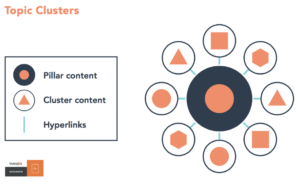Are you missing the SEO forest for the trees … getting lost in the granular details (like keywords) while losing sight of the bigger picture of overall content strategy?
If your inner Magic 8-Ball reads “The answer is certain” a simple solution called topic clustering, or the “wheel and spoke” method, can help.
If you want to learn how better organized content strategy can help improve SEO rankings, keep reading.
Happy Google, happy life
We’ve shared our own on-page SEO tool that helps you perfectly structure blog posts.
We’ve also shared how removing outdated content not only helps with SEO but also keeps your brand credible.
Now, we’re going to show you how a topic cluster content strategy can result in more organic traffic, directly feeding into Google’s E-A-T algorithm.
Expertise + Authority + Trustworthiness = E-A-T
Google’s E-A-T algorithm is intended to protect users from low-quality content.
As a content provider, gone are the days when any old blog post or page, haphazardly stuffed with keywords would land you on the first page of search results.
As a consumer, gone are the days spending endless hours sifting to page 23 of searchresults to find the information we’re looking for.
The primary purpose of topic clustering is to establish a main theme with interconnected content that demonstrates to the algorithm that your content is E-A-T-worthy.
What are topic clusters?
Topic clusters are simply a grouping of content addressing a central topic, using a pillar page to link to and from. Here’s one example from a project we helped City National Bank complete.

According to Semrsuh, topic clustering has several benefits for financial marketers, including:
- Better organized content making topics and your POV easier for readers to find… the main point!
- Improved SEO… eventually… internal links from cluster pages to pillar pages and back will give your blog authority over a particular topic over time.
- Increased content production speed happens once you’ve created a pillar page. The initial hard work done, cluster pages will be easier to ideate, research, and produce.
- More comprehensive content that helps minimize both overlap and gaps in subject matter, or going to deep in any one post.
Not only that, but the extra time you spend planning and building this content strategy will pay big dividends in site visitors spending more time on your site.
4 steps to topic cluster greatness
Want to create perfect pillars and compelling clusters? This process outline can get you started.
STEP 1: Define your big-picture theme
Recognize how your products and services can solve your clients’ pain points. Also, consider the benefits that your business can uniquely provide the market.
STEP 2: Strategize subtopics
Once you have a pillar idea, it’s time to create subpages. If you’re out of ideas, then ask your sales or support team for common client questions on a main topic. Then, structure your blog posts to double as blogs and FAQs. Do keyword research for these subpages.
STEP 3: Create links
Link your subpages to the pillar page. Analyze your current content roadmap to discover backlink opportunities to your new pillar page. You can use a tool like Sitebulb to show the linking relationship between your webpages.
STEP 4: Measure results
Use tools like Google Analytics 4 or the metrics offered by your CMS to see which pieces of content have the highest views, bounce rates, and conversion rates. These can show you which articles are adding the most value to each cluster.